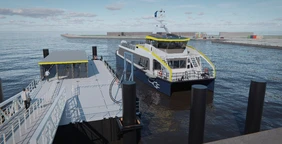The transport sector is responsible for about 23% of CO2 emissions and is thus a significant source of climate-damaging greenhouse gases. After road and air transport, a significant amount of global CO2 emissions falls on shipping. Worldwide, shipping is responsible for the emission of about one billion tonnes of carbon dioxide, which corresponds to 3 per cent of total man-made CO2 emissions. It also causes about 15 per cent of global nitrogen oxide emissions and 13 per cent of sulphur dioxide emissions. Finding ways to reduce these emissions is therefore crucial on the road to a climate-friendly future. The European project HYPOBATT, which stands for "Hyper powered vessel battery charging system", has brought together 18 key players from the European maritime sector. The aim is to develop and demonstrate a fast charging system for ships. Initially, the ferry service between the North German ports of Norddeich and Norderney will be electrified. For this purpose, HYPOBATT is supplying a modular, fast and predictive multi-megawatt charging system that will enable the ships to be connected to the charging station and charged within a very short time after docking. The project, which is part of an EU-wide Horizon initiative, focuses on developing a megawatt charging standard and charging infrastructure for ferries in European ports.
The all-electric ship (Fig. 1), which is planned as a catamaran and thus the first of its kind under the German flag, is scheduled to enter service as early as May 2024. The 32.3 m long hull will be powered by two 600 kW electric motors, and two 75 kW electric bow thrusters will assist in manoeuvring. The designed speed is 19 knots. A payload of 11,250 kg is possible. The catamaran can carry up to 150 passengers back and forth. The Norden-Frisia shipping company plans to use the ship mainly in the high season, with eight trips to the island of Norderney. The journey time for the eleven-kilometre route to the island is to be only 30 minutes. Back in Norddeich, the E-Cat will be fully charged in around 28 minutes and ready for the next tour.
On the THI side, the working group led by Prof. Dr. Hans-Georg Schweiger is participating in the three-and-a-half-year project. The Ingolstadt team has also taken over the management of public relations. From Ingolstadt, the project is now being publicised throughout Europe. To this end, public lectures and workshops are being organised and information on the current status of the project is being provided at trade fairs and conferences.
Three questions for Prof. Dr. Hans Georg Schweiger (Research Professor Battery Systems, Head of the CARISSMA Institute of Electric, Connected, and Secure Mobility (C-ECOS), Head of the Safe Electric Mobility Research Group at the Technische Hochschule Ingolstadt)
What is it like to be part of such a large-scale project, or how did THI come to be awarded the contract?
Being part of such a large-scale project can be an exciting and enriching experience for us and THI. It offers the opportunity to participate in groundbreaking research activities, develop innovative solutions and build valuable networks. By working with leading, European research institutions and companies, THI can benefit from their expertise, resources and infrastructure.
The award of a contract to THI as a partner in a major project may depend on a number of factors. These include the reputation of the university in certain subject areas, the expertise of the researchers involved, the infrastructure of the university, previous research results and references, and the potential for successful cooperation and project implementation.
As a rule, the award is made after a tendering process in which interested organisations submit their project proposals. These proposals are then evaluated by an evaluation commission and the best or most suitable projects are selected.
In the HYPOBATT project, partners from the European maritime sector have joined forces, how can THI integrate here?
As a partner from the automotive sector, we can contribute our expertise and experience in battery systems, energy efficiency, performance optimisation and reliability. By transferring this knowledge to the maritime sector, innovative solutions and technologies can then be developed that meet the specific requirements of the maritime industry.
At the same time, THI is working on safety-relevant topics here at C-ECOS. This expertise can be of great importance in the HYPOBATT project, as safety aspects play a prominent role in the maritime sector due to the size of the systems and possibly limited rescue options. Here we can share our expertise to develop safety concepts, risk assessments, contingency plans and technical solutions with our European partners to improve safety in maritime systems.
What significance do the project results have for Ingolstadt research?
Participation in a maritime project like HYPOBATT enables Ingolstadt research to expand its field of research and your expertise. International collaboration on innovative solutions and technologies in the maritime sector can identify new research questions and challenges that have the potential to open up new research areas and expand the research spectrum here at the university.
The project results can also be used to transfer the know-how and technologies developed in the HYPOBATT project to other research areas at the university. This will enable Ingolstadt's research to further develop its expertise and innovation potential and thus provide new impetus for future research projects.
If the final project results are relevant for companies and industrial partners, this can also strengthen future cooperation between THI and industry. The successful completion of the HYPOBATT project can bring the research potential and expertise of the THI into the focus of companies, which can lead to further industry partnerships and joint research projects.
Finally, our students benefit from the fact that THI deals with all facets of e-mobility. The resulting broad-based education makes our graduates sought-after professionals in the European e-mobility market.


![[Translate to English:] Logo Akkreditierungsrat: Systemakkreditiert](/fileadmin/_processed_/2/8/csm_AR-Siegel_Systemakkreditierung_bc4ea3377d.webp)








![[Translate to English:] Logo IHK Ausbildungsbetrieb 2023](/fileadmin/_processed_/6/0/csm_IHK_Ausbildungsbetrieb_digital_2023_6850f47537.webp)


